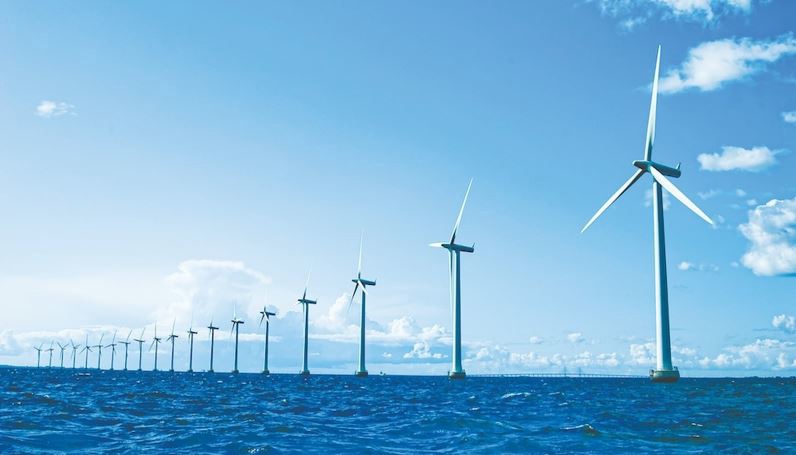Real appeal from offshore wind power potential
Foreign investors have been seizing the opportunity to play a larger part in developing Vietnam’s offshore wind power industry.

With a strategic location, more than 3,260 km of coastline, and abundant wind resources both onshore and offshore, Vietnam is fast emerging as a hotspot for global wind energy investment, especially as the green transition takes center stage on the world’s sustainability agenda.
On April 15, Deputy Prime Minister Bui Thanh Son signed Prime Ministerial Decision No. 768/QD-TTg, approving revisions to Vietnam’s National Power Development Plan for 2021-2030 with a vision to 2050 (PDP8). Under the plan, by 2030, the total capacity for onshore and nearshore wind power is projected to reach between 26,066 and 38,029 MW, out of a technical potential estimated at around 221,000 MW. For offshore wind power alone, the total installed capacity is expected to reach 6,000 to 17,032 MW between 2030 and 2035, with a long-term goal of 113,000 to 139,097 MW by 2050.
To realize these ambitions, attracting experienced foreign investors in wind energy plays a vital role, not only in accelerating Vietnam’s renewable energy development but also in shaping a green economy and fulfilling the country’s commitment to achieve net-zero emissions by 2050.
Eyes on Vietnam
In the opening months of this year, a wave of international energy giants has been accelerating their moves into Vietnam’s wind power market, signaling growing confidence in the country’s clean energy prospects.
In early March, Mr. Nate Franklin, Founder and Chairman of the US-based Pacifico Energy (PE), reaffirmed his group’s multi-billion-dollar commitment to offshore wind development in Vietnam during a high-profile meeting with Prime Minister Pham Minh Chinh. Mr. Franklin emphasized that these projects not only enhance Vietnam’s energy security but also help attract high-quality FDI into key sectors like semiconductors, data centers, and AI, fostering a more sustainable economic future.
He described Vietnam as a uniquely-positioned wind energy powerhouse in Asia, blessed with high wind speeds, a favorable coastline, and a strategic location. PE has already invested over $48 million into a 30 MW onshore wind farm in Ben Tre province (now part of the Mekong Delta’s Vinh Long province), slated to begin operations later this year.
European players are also staking out a presence in Vietnam. Germany’s PNE Group is advancing legal procedures for its Hon Trau offshore wind project in Binh Dinh province (now part of the central highlands’ Gia Lai province), valued at $4.6 billion. With a planned capacity of 2,000 MW across three phases, the project’s first 750 MW phase is expected to go live by 2030.
Meanwhile, Denmark’s Copenhagen Infrastructure Partners (CIP) has been deepening its engagement in Vietnam since 2019. In partnership with local stakeholders, CIP is developing the 3.5 GW La Gan offshore wind project in Binh Thuan province (now part of the central highlands’ Lam Dong province). The project is poised to anchor a comprehensive domestic supply chain for Vietnam’s wind industry.
Beyond direct project investment, strategic alliances are also gaining momentum. In May, China’s PowerChina signed a partnership with a Vietnamese company to establish a manufacturing facility in Ca Na in Ninh Thuan province (now part of south-central Khanh Hoa province) for wind turbine towers and steel structures, supporting projects aligned with the recently-revised PDP8.
This growing international interest reflects not only investor confidence in Vietnam’s market potential but also contributes significantly to the sector’s long-term development. The presence of reputable investors brings in critical capital, global know-how, and risk-mitigation strategies that help unlock Vietnam’s vast onshore and offshore wind resources.
According to Mr. Stuart Livesey, Country Representative of CIP and member of the Offshore Wind Task Force at the Vietnam Energy Partnership Group (VEPG), most foreign wind energy investors are taking a long-term view of Vietnam. Their goal is to build enduring partnerships, transfer technology, nurture local talent, and cultivate a robust domestic wind industry, not just pursue short-term returns.
He emphasized that Vietnam is regarded as a strategic long-term partner. His company aims to work closely with domestic firms to develop the offshore wind sector in a structured and methodical way, starting from initial groundwork to building a fully independent and self-sustaining industry.
This deepening collaboration comes at a pivotal time. Global FDI in renewables is surging, and Vietnam is quickly rising as a preferred destination. According to the International Renewable Energy Agency (IRENA), the country stands out for its exceptional natural potential and increasingly supportive government policies.
From paper to progress
Though Vietnam holds immense potential, many foreign investors still face significant challenges in implementing wind power projects in the country. According to Mr. Bruno Jaspaert, Chairman of the European Chamber of Commerce in Vietnam (EuroCham), European enterprises are greatly interested in Vietnam’s offshore wind sector but most projects remain “on the drawing board”, with no progress on actual development.
Specifically, Mr. Jaspaert noted that developing an offshore wind project typically requires at least six to seven years. Of this, the first three to four years are needed to complete legal procedures and secure financing, followed by around three years of construction. This means that if Vietnam is to achieve its target of 6,000 MW of offshore wind capacity by 2030, construction of the first projects must begin no later than 2027.
To meet this goal, he emphasized the need for Vietnam to swiftly finalize a comprehensive legal framework, establish a transparent and efficient support mechanism, and, most importantly, ensure clear protections for investors. Smooth coordination between relevant ministries and agencies is also critical to facilitating offshore wind project implementation.
From another perspective, Mr. Livesey highlighted that mechanisms such as feed-in tariffs (FIT), tax incentives, and fiscal policies have fueled rapid growth in solar and onshore wind development. However, emerging sectors like offshore wind, energy storage, and green hydrogen still lack tailored support policies. He stressed that the government must strike an appropriate balance between encouraging investment and managing risk, especially for multi-billion-dollar projects.
Vietnam should therefore develop a clear roadmap for offshore wind development, divided into specific stages from site surveying and construction to operation. Auction mechanisms, power purchase pricing, and licensing procedures must be transparent, consistent, and stable. In particular, developers who proactively conduct site surveys before bidding should be granted priority scoring during evaluation, to incentivize early commitment and reduce risks.
Beyond the regulatory aspects, Mr. Livesey also identified transmission infrastructure and seaport capabilities as two critical components that will determine the success of offshore wind projects. Vietnam’s power grid must also be upgraded to ensure flexible coordination and the ability to accommodate large-scale capacity. Meanwhile, seaports should be strategically planned and equipped to handle the transportation and installation of oversized and heavy equipment.
In reality, compared to traditional investment sectors such as industry or manufacturing, where profit projections are relatively straightforward, renewable energy, particularly offshore wind, still lacks a sense of “certainty” regarding the legal and investment environment. For this reason, Vietnam must strongly affirm that it offers a safe, transparent, and risk-controllable investment destination, in order to build investor confidence, reduce risks, and foster a wave of long-term, sustainable investment in Vietnam’s renewable energy sector in the years ahead.







